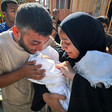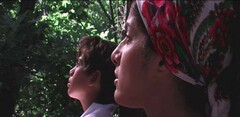The Electronic Intifada 20 February 2005
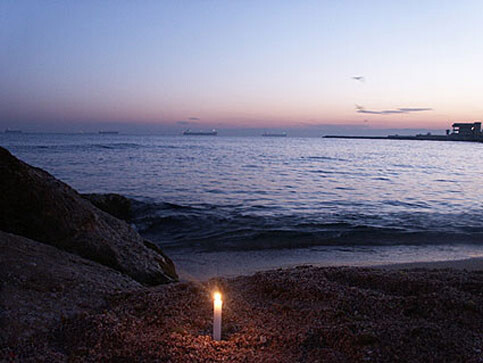
Detail from “Where We Come From” by Emily Jacir
One of my closest friends in high school was the daughter of a Palestinian refugee of Al-Nakba. Ironically enough, I didn’t have any idea of what it meant to be Palestinian or who the Palestinians were until my entire class was required to watch the Steven Spielberg film Schindler’s List in the school auditorium, followed by a talk by a concentration camp survivor and one of the American GIs who liberated the camps.
I remember my friend was very upset after watching the film, particularly with the scene in Israel in which visitors put the stones on Oscar Schindler’s grave. I couldn’t believe that she would question the value of the film or its historical worth. But she told me that to her, the film failed to tell what she considered to be the second chapter of the Holocaust — the establishment of the state of Israel and the expulsion of three quarters of a million people, including her father, from their homes and land.
A year later I was a freshman at a fine arts university in Chicago, specializing in painting and drawing, when the Al-Aqsa Intifada broke out. Like everybody else, I was shaken by the visual imagery coming out of the conflict — the video stills of the killing of 12-year-old Muhammad Al-Dura in Gaza, the bloody lynching of the two Israeli soldiers in Ramallah, and later the utter destruction in the Jenin refugee camp in spring 2002 and the horrible aftermath of suicide bombings in Israel.
The United States, fresh after September 11, had plenty of horrible images to occupy and haunt my mind. But always at the back of my head were the images coming out of Palestine-Israel, and I became increasingly interested in the battles being waged over them. It seemed that there were people out there dedicated to “disproving” certain images, like the ones of Muhammad al-Dura, as though these images were actually the source of the conflict.
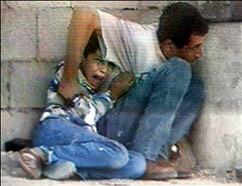
Mohammed al Dura with his father moments before his death
Of course, it wasn’t just the images being printed in the newspapers causing controversy —the language in news articles on the conflict has itself become an editorial battleground. But because most Americans get their news from looking at headlines and pictures, or watching television, rather than taking the time to read in-depth news stories, it is not without reason that interest groups have dedicated so much of their time to disputing images in the news, regardless of whether they are right to do so or not.
Particularly striking is the phenomenon that the daily human rights abuses being committed by Israel in the occupied Palestinian territories are largely ignored until they are captured on film. And this is not a phenomenon limited to Israel-Palestine. Imagery has always been important to politics, and imagery has never been immune to politics. But photography makes politics all the more immediate. For those thousands of miles away from this conflict, the regular brutality of the Israeli army doesn’t become real until international film crews tape in the 1980s a group of soldiers beating up two defenseless Palestinian men, and the daily humiliation and oppression of Palestinians at checkpoints doesn’t become relatable until Machsom Watch videotapes a young man at a checkpoint being ordered by Israeli soldiers to play a sad song on his violin.
In our busy world that is becoming increasingly reliant on quick visual information, the importance of what we see and how it informs our understanding of the world is only exaggerated when it comes to the Israeli-Palestinian conflict. This battle of the visual has been waged to the point of absurdity — in 2000, msnbc.com pulled its “Year in Pictures 2000” contest, in which readers voted for what they felt was the best picture of the year, off of its website after Israeli and Palestinian sympathizers tried to beat the other out by “stuffing” the ballot box. Palestinian sympathizers were voting for the video still of the shooting of Muhammad al-Dura, and Israeli sympathizers answered with a campaign to mass vote for some politically neutral pictures of puppies.
Because these media battles have been waged to such a point of absurdity that the function of culture as a means of understanding and communication is all the more relevant. Seeing how such high emotions run regarding Israel-Palestine, outsiders to this conflict frequently see Palestinian sympathizers and Israeli sympathizers as being equally extreme and unreasonable. The Palestinians say one thing, and the Israelis deny it, and vice versa. And because media reports rarely afford readers with any true understanding of the conflict, and instead just give the latest death statistics or latest soundbites from the major political players, there is a sense that the conflict is just too inaccessible to understand or care about. What results is people believing that the conflict is a tragic one of ancient hatreds, rather than modern actions, and there is nothing to be done but let the Israelis and Palestinians play it out amongst themselves.
Art and culture have the potential to supplement these gaps of misunderstanding, and to emphasize the humanity being threatened by the conflict. The nature of the media doesn’t allow for concentrated looks at various aspects of the conflict, or of the people that it affects. But art appeals to our reason and emotions simultaneously, and often helps us understand the complex by making the macrocosmic microcosmic.
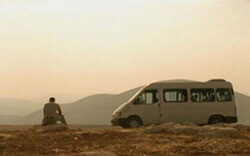
Image still from Ford Transit
The exporting of Palestinian art is particularly important because while the U.S., which can be considered a third party to the conflict, shares a sense of cultural identity with Israel, it holds very violent perceptions of Palestinians. When Americans see headlines and pictures of suicide bombings, they all too often make no distinction between Palestinians who blow themselves up at bus stops, Iraqi resistance fighters, and Al-Qaeda lunatics who fly planes into skyscrapers. Furthermore, it is only violent pictures that make the news — after all, if it bleeds it leads. And a half-dozen Israelis brutally killed in suicide bombings leads better than five hundred Palestinians becoming homeless after Israeli forces raze their houses in Rafah. And because Palestinians have been killed nearly every day during the intifada, their deaths seem to be considered no longer newsworthy, and their pictures aren’t seen.
In short, Palestinians have more to work towards when it comes to cultural as well as political understanding in the U.S., which of all other parties in the world has the most potential to influence Israel. After all, Israel has been successfully exporting culture since its establishment. The 1960 film adaptation of Leon Uris’ novel Exodus had a great impact in the U.S., portraying the Jews’ noble struggle with the unruly Arabs like that of the American pioneers’ struggle against the savage natives — a popular theme in movies at the time.
Palestinians start at negative 10 when it comes to exporting culture, because of all the misconceptions they face. Sadly, it seems like Palestinians have to first prove they are human for any kind of discussion to be initiated. There are so many misconceptions of Palestinians taken as truth in America, and perhaps in Israel, that time has to be spent correcting them before Palestinian culture can be acknowledged and accepted.
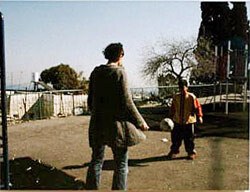
Detail from “Where We Come From” by Emily Jacir
Jacir’s work deals with displacement. Her most poignant project is perhaps “Where we Come From,” which is the result of her asking Palestinians living in Palestine and in the Diaspora, “If I could do anything for you anywhere in Palestine what would it be?” Taking advantage of her American passport, Jacir performed and documented the requests. While one of her requests was to play soccer with the first Palestinian boy she encountered in Haifa, another man asked her to visit his mother’s grave in Jerusalem on her birthday and pray, because he can only enter Jerusalem with the approval of the Israeli authorities. He was denied permission on her birthday the previous year. When Jacir went to the graveyard, there was a group of tourists visiting the nearby grave of Oscar Schindler.
Jacir’s work portrays in a very emotionally appealing way the everyday sufferings of Palestinians under occupation, and the longing of Palestinians in the diaspora. And there is a bittersweet irony with Jacir visiting a grave in the stead of a dead woman’s son, who is prevented from traveling to the cemetery because of Israel’s discriminatory policies, while tourists paying vigil to one of the heroes of Nazi resistance stand to her side.
In addition to Jacir and dozens of other young, sophisticated Palestinian artists, there is the small but growing hip-hop movement in Palestinian society, both in the OPTs and in cities like Lidd and Haifa in Israel. Using a musical form that in its heyday in the U.S. made strong statements about social change and justice, there are male and female rappers, such as DAM, Arapeyat, ZIL ZAL, We7, and MWR. There is a rap forum at the website www.arabrap.net, and different savvy Palestinian rappers are putting together their own websites where people can download their songs, because obviously it is difficult for them to get their music distributed by a record company. Additionally, a documentary by Palestinian-American artist Jackie Salloum on the Palestinian rap movement is currently in production, expected to be released this fall.
And there are enough high-quality films being produced in or about Palestine and issues surrounding Palestine to sustain an annual Palestinian film fest in Chicago, which has become increasingly popular in its four years and its screenings are held in what is arguably the best theatre in Chicago. One of the interesting things I’ve seen in attending the festival for the past two years is how it does much more than show through feature and documentary film the political situation in Palestine, but it also has been a point of self-reflection for the Palestinian community in Chicago.
Like the film Schindler’s List prompted an eye-opening discussion between me and my Palestinian-American friend in high school, one of the films screened two years ago sparked a heated discussion about what the role of the Palestinian filmmaker should be. The film that set off the discussion was Nazarene filmmaker Nizar Hassan’s Invasion, which was shot right after the siege of the Jenin refugee camp in spring 2002. What made this film controversial is how Hassan juxtaposed aftermath footage of the camp, and the stories of those who survived, with an interview with an Israeli soldier who operated one of the bulldozers during the siege.
After the film screened at the festival, the director was present, and there was a question and answer period. Some audience members completely rejected the idea of a Palestinian filmmaker giving an Israeli soldier who was responsible for much of the horror that happened during the siege a platform to speak freely and defend himself, when Palestinians are so rarely afforded that luxury. One viewer accused the filmmaker of treating the soldier like a sympathetic character, by employing close-ups of his face. Other audience members disagreed, and said that it was valuable for a film to take such risks, and get the audience to confront and question what they think about Israeli soldiers who commit such crimes. Otherwise, they said, it is just another film showing the suffering of the Palestinians, which doesn’t necessarily give momentum for change.
And Palestinian filmmaker Tawfiq Abu Wael’s films are challenging for all audiences. His short film Diary of a Male Whore is a quiet, disturbing look at how political and domestic violence shape a young man’s sexuality. And his first feature-length film, Atash, or Thirst, which was produced in Israel, interrogates paternalism and so-called honor killings in Palestinian society.
Indeed, young Palestinian filmmakers are doing what I think what the best artists do — interrogate society by asking difficult questions to which there are no easy answers, all the while presenting these difficult issues in an accessible way. It is films that tackle difficult questions that remain the most memorable, like the four and a half hour long Route 181: Fragments of a Journey in Israel-Palestine. Directed by the Palestinian filmmaker Michel Khalife and his Israeli peer Eyal Sivan, the film challenges what they think is an obstacle to the one-state solution — which they perceive as the best solution to the conflict.
Through their interviews with Israelis and Palestinians living along the green line, it is clear in the film that the filmmakers think that racism in Israeli society is the major roadblock to such a solution. And while there are very rational Israeli voices in the film, there are far more racist views espoused by Israelis than by Palestinians. For example, an Israeli construction manager of Moroccan descent says that the only good Arab is a dead Arab, and the camera pans along the side of a road, where signs in Hebrew read “Death to Arabs” and “the Palestinian state is in Jordan.”
When another Israeli interviewee tells of how he killed women and children during the 1948 war, and refuses to accept moral responsibility, the filmmaker asks him if he knows the Biblical story of Solomon. Of course, the story goes that Solomon recognized the true mother of a disputed baby to be the one who refused to split the child in two. The Israeli man, not initially recognizing that he’s falling into the filmmaker’s trap, then insists that the Arabs were killed “for our own survival.”
Art should challenge, but there is also a need for art that brings people together and soothes the mind. People in Palestine value the arts, and while life under occupation has made it difficult for artists to participate in cultural exchange and development, I have sensed a thirst amongst Palestinians for cultural enrichment. When there are events in Ramallah, they are usually packed. When the London Chorus and Chamber Orchestra played a Bach concert in Ramallah last December, the audience was filled with people of all ages. People were turned away at the door, so many people wanted to hear the performance. It was an hour during which people could set their minds free of the troubles that continually consume them and enjoy a fixed period of beauty. I also perceived that some parents had brought their children to see the performance of classical music, despite their kids’ short attention spans, so their children would subconsciously know there is potential for great beauty in their lives despite the ugliness and lack of hope that is so pervasive today.
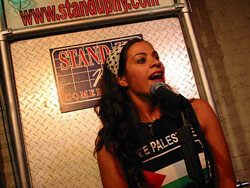
Maysoon Zayid
It’s impossible to look at Palestinian art and culture without regarding at the conditions of the society. These are not healthy conditions. Likewise, it’s impossible to expect a child who sees in his or her classroom empty desks belonging to classmates who have been killed in the conflict. And when unemployment and poverty are running as high as they are, survival comes before culture, and culture becomes one of survival. And while many Palestinians in the OPTs can’t spare money for artistic and cultural development — whether it be paying for a child’s music lessons or a family trip to the cinema — art is being used to help deal with the pressures the Palestinian people, and especially children, face.
Educators use drawing therapy as a means of healing for children who have experienced the repercussions of politics too complicated for them to understand. About half of all households in the OPTs have reported mental or physical illness in the family as a result of the conflict, and those most suffering from mental illness are women and children. Naturally, healthy childhood development is thwarted when a child witnesses violence, or doesn’t feel safe in his or her home or school. And while drawing cannot cure children of behavioral or psychological disorders, it is being used as a tool for them to begin to articulate their complex fears and anxieties in a way that doesn’t leave them emotionally vulnerable.
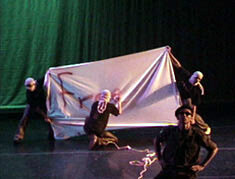
The Ibdaa dance troupe
The rousing choreography they performed included a dance interpreting the occupation. A boy dressed as an Israeli soldier, complete with a green uniform, black beret, and sunglasses, twirled with a rope a figure dressed in a flowing white gown, a scene that symbolizes the compromised freedom of the Palestinian people. However, not all refugee camps have centres like the Ibdaa centre, which gives young people a chance to embark on creative development. Far too many children in Palestine have a life consumed by conflict, and without creative outlets to deal with their stress.
And though daily life even in the bubble of Ramallah is dramatically affected by the occupation, people deal with it the best they can. I am charmed by how the hundreds of service taxis, old Ford trucks that were once used by Israel but flooded the territories after Oslo, have been personalized by their drivers. A couple of weeks ago I was in a service decorated with stuffed hearts and stars hanging from suction cups on the windshield. Heart decals with the words “comfort” were stuck to the side window, as if to say that though a passenger has to deal with the inconvenience of taking services between checkpoints, this driver was doing his part to make life as easy as possible.
I like to think of the service taxis as artifacts of the occupation. They wouldn’t be there if Palestinian citizens could freely drive their cars along whatever roads they choose in the West Bank and Gaza Strip. And to me, they represent the everyday resistance that Palestinians employ to hang on to any remaining normalcy when they have to deal with such extraordinary circumstances. I’ve seen services with slick black lights on the inside, and LED lights in the floor, as though they were little mobile dance clubs. And then there are services that have the words “No Fear” printed on the side, and then others with the ceilings decorated with prayer rugs, or small rugs with Ferraris or some other sports car printed them.
These little attempts at comfort, while not belonging to the realm of high art, indicate a culture trying to cling to stability when it is unknown what the next day will bring. While Westerners usually regard just the negative aspects of the traditional Palestinian society, to this writer, tradition — found in the habitual offerings to guests of sweet tea, and silently witnessed for generations by Palestine’s olive trees — and custom here calls upon the culture of a people with a unified history and, hopefully, future.

Naji Al-Ali’s “Handela” character
Palestinian art, literature, and culture should be pushed to the forefront. If this is not done, little will change regarding the U.S.’s perception of the Palestinian people. Edward Said explains what can happen when a people are perceived to be without a culture: “it is symptomatic of the intellectual will to please power, to tell it what it wants to hear, to say to it that it can go ahead and kill and bomb and destroy, since what is being attacked is really negligible, brittle, with no relationship to books, ideas, cultures, and no relation either, it gently suggests, to real people.” Although in this case Said was particularly discussing the Gulf War, the notion that a power can enforce its will on a people perceived to be without a culture can easily be found in the history of the Israeli-Palestinian conflict, even to the point when Israeli Prime Minister Golda Meir, as late as the 1970s, declared that there is no such thing as the Palestinian people.
Although no one, except maybe fans of Joan Peters’ academic fraud From Time Immemorial, would today argue that there is no such thing as the Palestinian people, one would be hard pressed to find outside of Palestine an image of Palestinians that isn’t inherently political, militant, or violent. Though it certainly is important for the historically invisible Palestinians to get their political and humanitarian needs at the center of international politics, there is something lacking. What is lacking is a sense among Americans, and maybe many Israelis, that Palestinians are average human beings, like us, who wish to work, care for their families, tend gardens, read, and enjoy all of the other banal aspects of life that conflict with the image of rock-throwing, suicide-bombing Palestinians. Until the American public is given (because more likely than not they’re won’t look for it themselves) an alternative image of Palestinians, it is unlikely that a major shift in U.S. opinion of the Israeli-Palestinian conflict will be made. And until that shift is made, it is likely that the status quo will continue for the Palestinians, as it has continued for decades.
Of course, Palestinian culture and art shouldn’t and isn’t being produced in order to prove to the rest of the world that they are humans, or for political gain. But if the world were able to more regularly see and hear the culture being produced in Palestine, there would be a lot more awareness of this very troubled and misunderstood part of the world.
Currently living and working in Ramallah, Maureen Clare Murphy is Arts, Music and Culture Editor for the Electronic Intifada
Related links:
